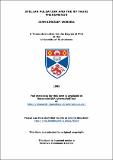Files in this item
Stellar pulsation and the RV Tauri phenomenon
Item metadata
| dc.contributor.advisor | Carson, T. R. (Thomas Richard) | |
| dc.contributor.author | Worrell, John Kingsley | |
| dc.coverage.spatial | 496 | en_US |
| dc.date.accessioned | 2015-04-16T15:51:19Z | |
| dc.date.available | 2015-04-16T15:51:19Z | |
| dc.date.issued | 1985-03 | |
| dc.identifier | uk.bl.ethos.571490 | |
| dc.identifier.uri | https://hdl.handle.net/10023/6509 | |
| dc.description.abstract | On the basis of observational data it is argued that RV Tauri variables, and probably yellow semiregular (SRd) variables, are closely related in every way to type II cepheid stars. Assuming that a single mass (~O.6 M~) is applicable to all three classes of star linear, nonadiabatic pulsation models are calculated. Using these models, the observed effective temperatures, and periods for these stars new luminosities are calculated and compared with the observed luminosities. This comparison appears to confirm the relationships between the three classes implied by the observations for the globular cluster stars. It is shown that an interaction of two or more pulsation modes could be responsible for the characteristic light curves of the RV and SRd stars but it is argued that this is unlikely. One RV star and a high luminosity F star both exhibit pulsations with two periods. The periods together with the observed effective temperatures and linear pulsation calculations yield masses and luminosities for the two stars. On the basis of the linear pulsation calculations the peculiar characteristics of the pulsations are explained. A sequence of nonlinear pulsation models based on the "standard" physics is presented. The light curves for some of these models show features characteristic of the RV stars. Strange behaviour found in the luminosity at the surface of some models is shown to be a product of an inadequate boundary condition. An alternative is suggested which cures the problem. Nonlinear models calculated with the new boundary condition eject matter, form very extended atmospheres, exhibit semiregular RV - like light curves with a (possibly) cyclic variation of the phase of light minima, and show long term variations of mean effective temperature. strong shock waves exhibiting properties like those found in RV stars are found. It is suggested that the equilibrium diffusion approximation is inappropriate for these models and the consequences of its use discussed. | en_US |
| dc.language.iso | en | en_US |
| dc.publisher | University of St Andrews | |
| dc.rights | Creative Commons Attribution-NonCommercial-NoDerivatives 4.0 International | |
| dc.rights.uri | http://creativecommons.org/licenses/by-nc-nd/4.0/ | |
| dc.subject.lcc | QB838.T2W7 | |
| dc.title | Stellar pulsation and the RV Tauri phenomenon | en_US |
| dc.type | Thesis | en_US |
| dc.type.qualificationlevel | Doctoral | en_US |
| dc.type.qualificationname | PhD Doctor of Philosophy | en_US |
| dc.publisher.institution | The University of St Andrews | en_US |
This item appears in the following Collection(s)
Except where otherwise noted within the work, this item's licence for re-use is described as Creative Commons Attribution-NonCommercial-NoDerivatives 4.0 International
Items in the St Andrews Research Repository are protected by copyright, with all rights reserved, unless otherwise indicated.


